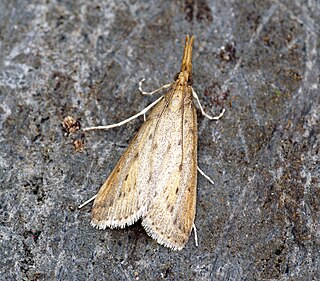
Donacaula forficella is a species of moth of the family Crambidae described by Carl Peter Thunberg in 1794. It is found in China (Heilongjiang), Europe and South Africa.

Donacaula mucronella is a species of moth of the family Crambidae. It is found in Europe.

Donacaula is a genus of moths of the family Crambidae. The genus was erected by Edward Meyrick in 1890.

Donacaula niloticus is a species of moth in the family Crambidae. It is found in Bulgaria, Romania, Greece, China (Gansu), Turkey, Russia, India and North Africa, including Algeria and Egypt.

Schoenobiinae is a subfamily of the lepidopteran family Crambidae. The subfamily was described by Philogène Auguste Joseph Duponchel in 1846.
Donacaula ignitalis is a moth in the family Crambidae. It was described by George Hampson in 1919. It is found in South Africa.
Donacaula phaeopastalis is a moth in the family Crambidae. It was described by George Hampson in 1919. It is found in South Africa.
Donacaula aquilella is a moth in the family Crambidae. It was described by James Brackenridge Clemens in 1860. It is found in North America, where it has been recorded from Alabama, Georgia, Massachusetts, Mississippi, New Jersey, New York, North Carolina and South Carolina.
Donacaula dispersella is a moth in the family Crambidae. It was described by Robinson in 1870. It is found in North America, where it has been recorded from Alberta, Manitoba, Nova Scotia, Ontario, Quebec, Saskatchewan, Arizona, Arkansas, Colorado, Connecticut, Florida, Georgia, Illinois, Kansas, Kentucky, Louisiana, Maine, Maryland, Massachusetts, Michigan, Mississippi, Nebraska, Nevada, New Hampshire, New Jersey, New York, North Carolina, Oklahoma, Pennsylvania, South Carolina, Tennessee, Texas, Utah, Vermont and Virginia.
Donacaula longirostrallus, the long-beaked donacaula moth, is a moth in the family Crambidae. It was described by James Brackenridge Clemens in 1860. It is found in North America, where it has been recorded from Nova Scotia, Ontario, Quebec, Alabama, Arkansas, Connecticut, Florida, Louisiana, Maine, Massachusetts, Michigan, Mississippi, Nebraska, New Jersey, New York, North Carolina, Pennsylvania, Texas, Vermont and Virginia.
Donacaula maximellus is a moth in the family Crambidae. It was described by Charles H. Fernald in 1891. It is found in North America, where it has been recorded from Florida, Georgia, Louisiana, Mississippi, Nebraska, North Carolina and South Carolina.

Donacaula melinella is a moth in the family Crambidae. It was described by James Brackenridge Clemens in 1860. It is found in North America, where it has been recorded from Ontario, Alabama, Arizona, Arkansas, Connecticut, Delaware, Florida, Georgia, Illinois, Indiana, Kentucky, Louisiana, Maine, Maryland, Massachusetts, Michigan, Mississippi, Nebraska, New Jersey, New York, North Carolina, Pennsylvania, South Carolina, Texas and Virginia.
Donacaula montivagellus is a moth in the family Crambidae. It was described by Philipp Christoph Zeller in 1863. It is found in Venezuela and Cuba.
Donacaula nitidellus is a moth in the family Crambidae. It was described by Harrison Gray Dyar Jr. in 1917. It is found in North America, where it has been recorded from Alberta, Alabama, Connecticut, Georgia, Maryland, Massachusetts, Mississippi, New Jersey, New York, North Carolina, South Carolina and Texas.
Donacaula pallulellus is a moth in the family Crambidae. It was described by William Barnes and James Halliday McDunnough in 1912. It is found in North America, where it has been recorded from Alabama, Arizona, California, New York and Texas.
Donacaula sicarius is a moth in the family Crambidae. It was described by Philipp Christoph Zeller in 1863. It is found in Venezuela.
Donacaula sordidellus is a moth in the family Crambidae. It was described by Johann Leopold Theodor Friedrich Zincken in 1821. It is found in North America, where it has been recorded from Florida, Louisiana, Mississippi, Nebraska, New Jersey, New York, North Carolina, North Dakota, South Carolina and Texas.
Donacaula tripunctellus is a moth in the family Crambidae. It was described by Robinson in 1870. It is found in North America, where it has been recorded from Arkansas, Florida, Louisiana, Mississippi, Oklahoma and Texas.
Donacaula unipunctellus is a moth in the family Crambidae. It was described by Robinson in 1870. It is found in North America, where it has been recorded from Nova Scotia, Alabama, Florida, Georgia, Louisiana, Maine, Mississippi, New Jersey, New York, North Carolina, South Carolina, Texas, Utah and Virginia.
Donacaula uxorialis is a moth in the family Crambidae. It was described by Harrison Gray Dyar Jr. in 1921. It is found in North America, where it has been recorded from Florida and Texas.





